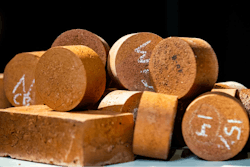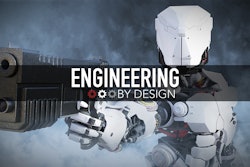Giulia’s Hot New Plastic
BASF designed a new heat-resistant plastic that debuted on Alfa Romeo's 2017 Giulia.
According to Honeywell, 70 percent of light vehicles worldwide will use turbocharged engine technology by 2020. In an attempt to capitalize on teh potential new market, BASF designed Ultramid Endure, a polyamide with high heat aging resistance up to 220°. It was recently specified into two new powertrain applications: an air intake manifold with an integrated charge air cooler, and a hot-side turbo duct. Both debuted on Giulia's new 2.0L GME engine.
The 2.0-liter engine delivers 280 horsepower and 306 lb.-ft. of torque, and can go from 0-60 mph in 5.1 seconds with a top speed of 149 mph.
BASF collaborated with Toronto, Canada-based automotive supplier ABC Group to develop Giulia’s hot-side turbo duct. ABC Group used BASF’s Ultramid Endure D5G3 BM, a 15 percent glass fiber reinforced blow-molding grade, because of its high melt strength and heat-aging resistance. ABC also worked with BASF to optimize the infrared (IR) welding parameters for the part, which was crucial to achieve strong welds and insure long-term durability.
For the air intake manifold, BASF worked with Italian automotive design and manufacturing company Magneti Marelli. The materials had to withstand 200°C of continuous use so Magneti used BASF’s D3G7, a 35 percent glass fiber-injection molding grade. The manifold has a burst pressure requirement; so, the company needed something with a more reliable weld strength at elevated temperatures.
Gold Train Costs a Fortune to Ride
This Monday, the East Japan Railway Company launched the Train Suite Shiki-shima, a 10-car train that will only carry at most, 34 passengers. At first, it seems like a flawed business model. How will the company make money?
Well, a ticket to ride this luxury train starts at $3,000, and can cost up to $10,000. The price may seem high, but the company has sold out through March 2018.
The train is a pretty interesting design by Ken Okuyama, an industrial designer with credentials from GM, Porshe, Ferrari, and Maserati. For example, both the engine and caboose are glass-walled cars to offer a unique viewing experience.
Okuyama's design of the champagne-gold-colored train includes an abundance of traditional materials particularly wood and origami paper (washi), all custom made.
With every trip, the company promises, “A journey that will bring you the happiness of knowing that there are still new discoveries to be made.” As long as you can afford it.
Making Brick Buildings Out of Moon Dust
The European Space Agency is 3D printing bricks made of moon dust using only the only the heat from the sun. The exercise served as a proof-of-concept as to how future lunar colonists could build settlements on the moon, potentially starting with a multi-dome lunar base concept.
Working with concentrated sunlight, the materials engineers used simulated lunar dirt made from volcanic material and cooked it in a solar furnace. They used a 3D printer table, and baked 0.1 mm layers of moon dust at 1,000°C, using 147 curved mirrors that focused sunlight into a high-temperature beam and melted the soil grains together. They produced a 20 cm x 10 cm x 3 cm brick, which is about the same length and width of a standard brick (but half of the height) in about five hours. The bricks are now undergoing detailed mechanical testing.
They did run into some problems as a few of the bricks warped at the edges because that part of the brick cools faster than the center, which they hope to solve by accelerating the printing speed.
But let’s talk timeline. Forget that massive lunar base, let’s say we want to start with a simple 10’ x 10’ moon shed. With normal bricks, you need 6.3 bricks per square foot. That’s 2,520 normal bricks for our moon shed, and 5,040 moon dust bricks. That will take 25,200 hours of print time, or about three years if that 3D printer and solar furnace are up and running 24/7.
Hopefully, they can figure out a roof while they're waiting on bricks, though I suppose this lunar base will be more of an igloo made out of moon bricks.
Maybe they can find a way to make more of a moon dust concrete that they can run through a massive printer like that one that was 3D printing homes in Russia in 24 hours.
This is Engineering By Design with David Mantey.






















